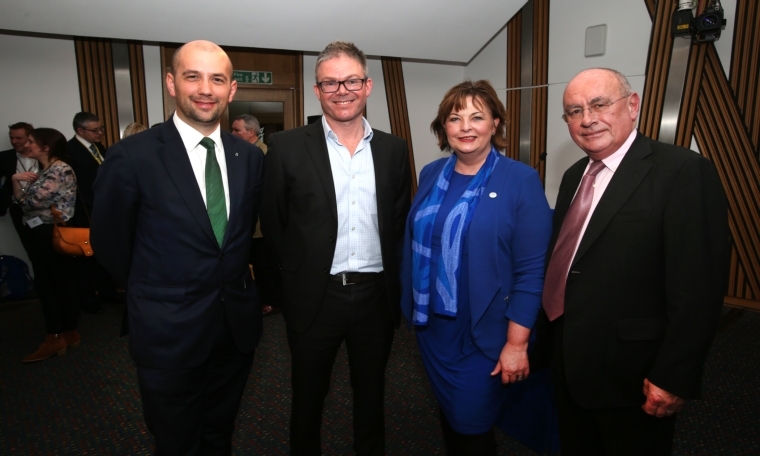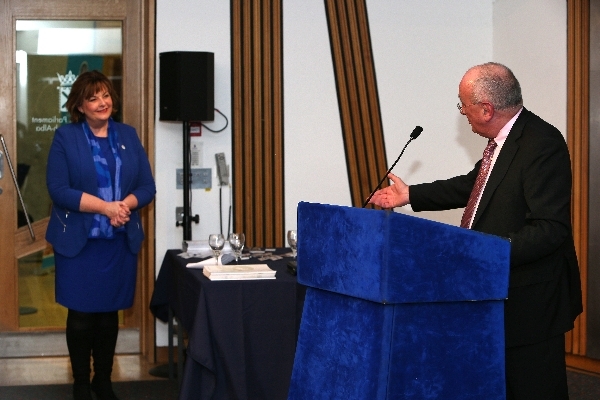
Our Chairman, Lord Currie, delivered a keynote speech at our first Scottish Parliament reception on 12 December about regulating online advertising. The event was hosted by Ben Macpherson MSP, and we were delighted that the Scottish Government Cabinet Secretary for Culture, Tourism and External Affairs, Fiona Hyslop MSP, was our guest speaker.
Lord Currie said:
It is a great pleasure to be back in Edinburgh and so soon after becoming ASA Chairman. I have had the privilege of chairing both Ofcom and the CMA (which continues for a while). And in each of those organisations I made it a priority to ensure effective communication and dialogue with all parts of the United Kingdom, especially the devolved administrations. On becoming Chairman of the ASA, I was therefore very pleased to find that this priority was embedded in the workings of the organisation, as Guy has so clearly explained.
What I would like to talk about this evening is the regulation of digital advertising. First a striking fact: advertising that just six years ago was not covered by the ASA system now makes up half our workload – testament, I think, to the flexibility and adaptability of the self-regulatory system.
Prior to March 2011 the ASA regulated ads in paid-for space online but not companies’ own advertising claims on their own websites and social media spaces.

Of course, consumers draw no distinction between paid-for advertising online and the material they see on websites and platforms which are under the control of advertiser. They expect advertising to be just as honest and truthful on those sites as if it appeared on TV or in print. To meet those expectations, the ASA system extended its remit to cover online ‘advertiser-owned’ advertising in 2011.
Six years on and the ASA’s workload has been transformed. Over the period, we resolved over 41,000 complaints relating to almost 37,000 online advertiser-owned ads. That accounts for one in three of cases resolved.
The data reveals some interesting things. Most complaints – 73% last year - are about ads people think are misleading – unsubstantiated or exaggerated claims and the omission of relevant information. But for ads on companies’ own websites and social media platforms the proportion is much higher, at 88%. It seems that misleadingness is a still greater problem on these online advertiser-owned spaces.

For regulation to be effective, ASA rulings need to be enforced. In paid-for media, there are gatekeepers who take down ads that are judged inappropriate – a great strength of the ASA self-regulatory system has been effective enforcement by the industry itself. But of course on company-owned spaces, no such gatekeeper exists. So we made arrangements for search engines to take down paid-for search ads where an advertiser persistently breaches the advertising codes. A dedicated part of our website details persistent offenders, optimised to appear in search engine results. And we run our own paid-for search campaigns highlighting non-compliance.
These online sanctions have worked remarkably well. But when they do not, we will refer non-complying advertisers to our legal backstop, Trading Standards. Over the period since Trading Standards took up that role, the ASA resolved over 58,000 cases, 18,000 of which resulted in compliance action, with only 53 referrals to Trading Standards and only 4 prosecutions – a highly effective funnel that demonstrates that the self-regulatory system is working. We do the heavy lifting and handle the vast majority of cases, referring just a few well-documented cases to Trading Standards.
Let me turn to the protection of children, a top priority for the ASA. 5-15 year olds now spend more time online than watching TV on a television set. Parents rightly expect that their children are shielded from inappropriate ads online as has been the case on TV. That is why the Committee of Advertising Practice, which writes the codes that we enforce, introduced an effective ban on targeting ads for food and drinks high in fat, salt or sugar (so-called HFSS) at children in non-broadcast media – including online. This includes ads on companies own websites, their social media spaces and also in content like advergames. This brings this broader media landscape into line with broadcast advertising.

Tough standards are also in place for the content and targeting of alcohol ads. The Advertising Codes are very clear: Ads must be socially responsible and cannot condone excessive drinking. They can’t claim that alcohol can make you more popular or attractive. They can’t show alcohol being served irresponsibly, including in rounds. And crucially, social responsibility means making sure that ads aren’t directed at people under 18.
This last requirement applies online as strongly as in traditional media. Social media platforms allow advertisers to filter out users with a date of birth under 18, but such filters can be easily bypassed. Because of this, CAP and the ASA this year further toughened the targeting standards. We now require advertisers to show they’ve made good use of platforms’ interest-based targeting tools to filter out young people. Crucially the burden of proof is on the advertiser to show that they have acted responsibly.
The rapidly morphing nature of social media brings new opportunities for brands to advertise: blogs, vlogs, tweets, posts, and snaps. Any advertising on these channels needs to be recognisable: there needs to be honesty and transparency about where editorial ends and marketing begins. If an influencer is paid to promote a brand and the brand controls the message, then that is an ad. We don’t want to stop that – we absolutely believe in advertising on all media – but ads needs to be identified. ‘#ad’ as an identifier or something similar and clear is a simple solution.

Unfortunately many are falling short. Particular offenders are TV celebrity influencers on platforms such as Instagram. Disclosure is in the long-term interests of influencers as well as consumers. If trust breaks down because people feel they are being misled, that will damage the influencer’s own brand. We’ll continue to take a strong stand, including through publishing research into consumers’ ability to recognise when they’re being advertised to online.
This is a newer area for us, and a further example of how the ASA follows the business. The flexibility of self-regulation allows us to do this rather than standing in queue for legislative slots. This is good both for business and consumers.
Let me conclude very swiftly with two other points about our work online. First, last year we tightened very considerably the way that price claims about broadband pricing can be made, to the considerable benefit of consumers. And last month CAP changed the requirements for speed claims in broadband ads, so that they bring such claims much closer to reality. Broadband plays an increasingly crucial role in people’s lives, both at home and at work. As in all other areas, ads must not mislead.
Advertising plays an important role in our lives. It is entertaining, an important source of creativity, an important business, and one in which the UK is a world leader. It also informs us as consumers. The work of the ASA is to ensure that consumers are well-informed without being misled, and without placing an undue burden on business in doing so. I have always thought it did a great job in fulfilling these demand. That is why I feel privileged to head the organisation.

More on
-
Keep up to date
Sign up to our rulings, newsletters and emargoed access for Press. Subscribe now.


